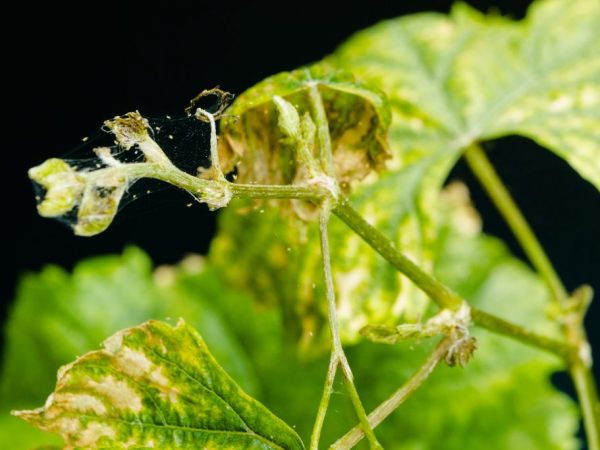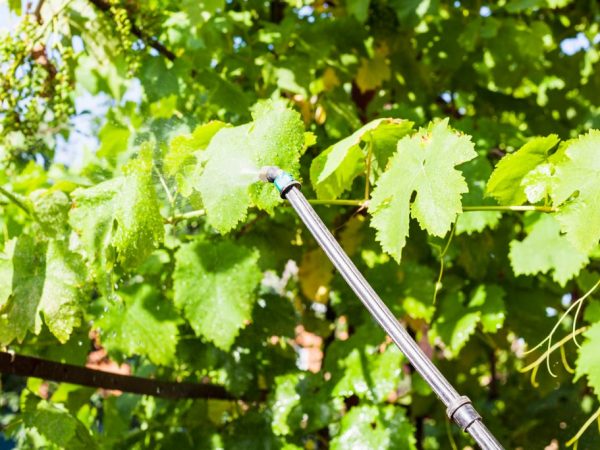Fighting the leaf roll on grapes
Pests of grapes lead to inhibition of plant development, a decrease or lack of yield. The leafworm on grapes has reached the greatest distribution among insects. It should be dealt with in a complex way, using chemical, folk remedies.

Fighting the leaf roll on grapes
Description of pests
The most dangerous are grape leaf rollers of 2 types: bunchy and grape. They belong to the moth, because they eat garden plants and shrubs.
The insect looks like a small moth or moth. The most dangerous are caterpillars. They can lead to losses of grape yield up to 70%.
Grape leafworm
The bunchy grape roll has a body length of 11-12 mm. A butterfly with a wingspan of up to 19-20 mm stands out with a bright pattern. Its front wings are colored gray-green, yellow, dark gray. The colors are combined with a mosaic pattern.
Butterflies begin to fly when the air temperature warms up to 14 ° C. Their years lasts about 35 days. A female butterfly lives from 3 to 4 days, laying one lenticular egg (up to 100 pieces in total). They are transparent yellow. After 6-10 days, gray-green or olive caterpillars up to 10 mm long appear from them in adulthood. They are mobile. The head and the back of the head are covered with shields of a golden hue.
The leafworm forms into a narrow, pointed at the end pupa of a brown-olive shade. The length reaches 6 mm.
Wintering by the pupa takes place under the bark of trees, at the base of the trunk. Penetrates under the bark through cracks, frost holes.
The caterpillars have adapted to the cycle of the vineyard. They do harm by eating parts of the plant:
- 1st generation feeds on buds, flowers, young ovaries;
- 2nd generation eats unripe fruits;
- 3rd generation gnaws ripe fruits.
A bunchy leafworm wraps around parts of the vineyard with cobwebs, sucking the juices out of it. Leaves, berries cease to feed from the whole plant. They lack nutrients. The exchange is slowing down. During rainy, foggy weather with high humidity, the affected branches and fruits rot, spreading the rot throughout the plant.
Grape leafworm
The insect (Sparganothis pilleriana Schiff) is distinguished by an elongated mouth apparatus, gray-brown hind wings. The wings in front are green, shiny or ocher.
There is a grape roll with brown-gray transverse stripes on the wings. They appear in males.
The butterflies appear in the evening and at night in July and August. The insect lives up to 10 days.
Laying of 40-45 eggs occurs in one clutch. It has a flat oval shape. The eggs settle on the outside of the grape leaves, forming a white, sticky mass. Larvae develop up to 20 days under favorable temperature conditions. The color of the outer shell of eggs determines their age:
- immediately after laying, they are light green;
- after 10 days the color turns brown;
- eggs turn black before hatching;
- the shell remaining without eggs has a silvery tint.
After hatching simultaneously, the larvae reach a length of 1.8 mm. They are able to immediately crawl over the deciduous part of the tree. In the absence of food, they fall on the bark, going down the cobweb. They spend the winter there. Pre-wrapped with a thin shell. Its length reaches 2 mm, width ー 0.4-0.6 mm. The shell is strengthened with nibbled pieces of wood. This protection is able to withstand up to -26 ° C-27 ° C.
Caterpillars leave the wintering site with an interval of several weeks. They eat the grape buds from the inside. Then they move to young leaves.
Leaves curl, turn brown-red. They gradually dry up, fall off. In case of severe damage, the grape bush can completely lose its leaves.
Chemicals

Handle with care
Insecticides can be effectively used together with fungicides to control leaf rollers on grapes. They stop processing the plant a month before the start of harvesting.
The preparations are highly toxic to bees, moderately toxic to warm-blooded animals. Dilution of drugs in the correct concentration protects the vineyard. When working with chemicals, the following recommendations are followed:
- protect the face, hands, other parts of the body with overalls, a gas mask;
- high rubber boots are put on their feet;
- processing is carried out early in the morning or late in the evening;
- do not eat, drink, or smoke during spraying.
Fighting the grape leafworm
Use the drug "Tokution" with the active ingredient protiophos. It is based on the contact-intestinal effect on the insect's body. It is sold in a concentration of 50% emulsion or 40% powder.
All parts of the plant are sprayed during the growing season. The emulsion is diluted in a proportion of 0.6-2.0 l / ha. They are processed 4 times per season. The substance is dangerous for beneficial insects (including bees, ladybirds).
Means "Cymbush" has a contact effect. Possible 10%, 25% concentration. The consumption rate of the substance is 0.7-0.9 l / ha (10%), 0.26-0.4 l / ha (25%). They spray the vineyard three times a season.
Adherence to the recommended dosage ensures complete safety of the product for humans.
"Ekamet" (active ingredient - satisfar, etrimphos) is used as a multipurpose insecticide. It is consumed 1.5-2.0 l / ha, treatment is carried out 5 times per season during vegetative growth. The last spraying is performed 40-45 days before the final ripening of the berries before harvest.
Fighting the grape leaf roll
For control during the growing season, the same methods are used as for the grape leafworm. Treat the vineyard efficiently in autumn and winter. On the stiff branches, the bole is directed a strong stream of diluted preparations. This helps to get hold of the pupae of the insects hibernating in the holes in the bark.
The chemical pesticide Nitrafen is used. It is composed of sodium salts. The concentration is selected 2-3.5%, which reduces phytotoxicity. It is poisonous to humans, and therefore requires enhanced protection when used.
The drug "DNOC" with the active ingredient dinitroorthocresol is effective. The product penetrates into the bodies of pests in wet weather, the presence of precipitation. 10 g of the drug is diluted with water in a 1: 2 ratio, mixed. Add 10 L of water. The plant is sprayed at an air temperature of 5 ° C and below.
Folk remedies
Among the available safe methods, the effective use of tobacco infusion (100 g / 1 l of boiling water) or a decoction of wormwood (5 branches / 1 l of boiling water). Means insist day in a cool dark place. The berry is sprayed generously after the flowering period every day for a week.
Butterfly traps will help you get rid of leaf rollers on grapes. Use the bait with wine. Plastic bottles are cut and hung near the berries. Pour wine with vinegar, sugar. The trap is used immediately after the appearance of butterflies during a drought period. The liquid is often changed, because in the open air it changes its composition due to weather and precipitation.
Every morning the bottles are checked for leaf rollers on the grapes. The more pests caught, the less eggs will be laid in the vineyard.
Light traps are an alternative method of controlling insects. They act on males. Females are caught by hanging odors on the plant that are identical to male pheromones.
Conclusion
Grape varieties with dense bunches are not resistant to the leaf roll. Among them are Biruintsa, Riesling, Pinot noir, Gewurztraminer. When choosing, they pay attention to species with medium or high immunity to the pest. These include December grapes, Liana, Lancelot, Moldova.


